Broekmans & van Poppel
Experts in classical music and opera CDs and sheet music, this shop has perhaps the best selection in the city.
During the nineteenth century, Amsterdam grew beyond its restraining canals, gobbling up the surrounding countryside with a slew of new, mostly residential suburbs. Museumplein served as an introduction to these new developments, a large triangular open space surrounded by the cream of the city’s museums. The largest is the Rijksmuseum, which occupies a huge late nineteenth-century edifice overlooking the Singelgracht and possesses an exceptional collection of art and applied art. Close by, the more modern Van Gogh Museum boasts the finest assortment of Van Gogh paintings in the world, while the adjacent Stedelijk Museum boasts an outstanding collection of modern art, though it’s closed for extensive refurbishment until at least 2012. Out on this side of the city also is the Vondelpark, Amsterdam’s largest and most attractive green space, whose gently landscaped rectangle of lawns and paths, lakes and streams provides the perfect place for a lazy picnic between museums. The leafy streets around the park, such as PC Hooftstraat, also provide some of the most upmarket shopping in Amsterdam.
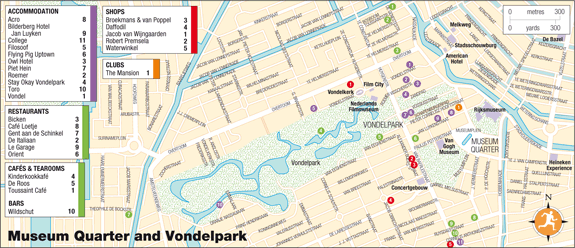
Extending south from Stadhouderskade to Van Baerlestraat, Museumplein’s wide lawns and gravelled spaces are used for a variety of outdoor activities, from visiting circuses to political demonstrations. There’s a war memorial here too – it’s the group of slim steel blocks about three-quarters of the way down the Museumplein on the left-hand side. It commemorates the women of the wartime concentration camps, particularly those who died at Ravensbruck.
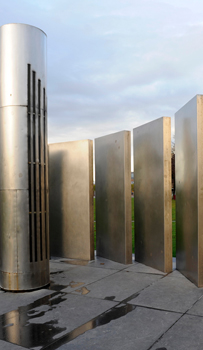
Entrance to the Philips Wing of the Rijksmuseum is on Jan Luijkenstraat
![]() 020/674 7000
020/674 7000
Daily 9am–6pm
€12.50
The Rijksmuseum is without question the country’s foremost museum, with one of the world’s most comprehensive collections of seventeenth-century Dutch paintings, including twenty or so of Rembrandt’s works, plus a healthy sample of canvases by Steen, Hals, Vermeer and their leading contemporaries. The museum also owns an extravagant collection of paintings from every other pre-twentieth-century period of Dutch art and has a vast hoard of applied art and sculpture. The bad news is that there’s a major renovation going on at the moment and most of the museum is closed, probably until 2013. The exception is the Rijksmuseum’s Philips Wing, whose smallish but eclectic “Masterpieces” exhibition, scheduled to last until the rest of the museum is reopened, is devoted to the paintings of Amsterdam’s Golden Age. Bear in mind, though, that queues can be long, especially in summer and at weekends, so try to book online ahead of time.
Even if you do have to queue, it’s still worth the wait, as the selection on display is superb. There are paintings by Rembrandt’s pupils – Ferdinand Bol, Gerard Dou and Gabriel Metsu; several wonderful canvases by Frans Hals, such as his scatological Merry Drinker; the cool interiors of Vermeer, Gerard ter Borch and Pieter de Hooch; soft, tonal river scenes by the Haarlem artist Salomon van Ruysdael and by Albert Cuyp; the cool church interiors of Pieter Saenredam; and the popular carousing peasants of Jan Steen. However, it’s the Rembrandts that steal the show, especially The Night Watch of 1642 – perhaps the most famous and probably the most valuable of all the artist’s pictures – plus other key works, like a late Self-Portrait, a touching depiction of his cowled son, Titus, the arresting Staalmeesters and The Jewish Bride, one of his very last pictures, finished in 1667.
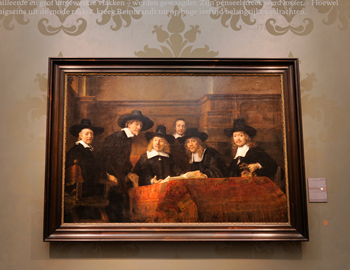
Paulus Potterstraat 7
![]() 020/570 5200
020/570 5200
Daily 10am–6pm, Fri until 10pm
€14, under 17 free
The Van Gogh Museum, comprising a fabulous collection of the artist’s (1853–90) work, is one of Amsterdam’s top attractions. The museum occupies two modern buildings, with the kernel of the collection housed in an angular building at the front designed by a leading light of the De Stijl movement, Gerrit Rietveld, and opened to the public in 1973. Beautifully presented, this part of the museum provides an introduction to the man and his art based on paintings that were mostly inherited from Vincent’s art-dealer brother Theo.
All of Van Gogh’s key paintings are featured on the first floor, displayed chronologically, starting with the dark, sombre works of the early years like The Potato Eaters and finishing up with the asylum years at St Rémy and the final, tortured paintings done at Auvers, where Van Gogh lodged for the last three months of his life. It was at Auvers that he painted the frantic Ears of Wheat and Wheatfield with a Reaper, and it was a few weeks after completing these last paintings that Van Gogh shot and fatally wounded himself.
The two floors above provide back-up to the main collection. The second floor has a study area with access to a detailed computerized account of Van Gogh’s life and times, while the third floor has a number of his sketches and a handful of less familiar paintings. The third floor also affords space to relevant temporary exhibitions illustrating Van Gogh’s artistic influences, or his own influence on other artists, many of whom influenced his work – among them Gauguin and Millet.
To the rear of Rietveld’s building, and connected by a ground floor-level escalator, is the ultra-modern curved annexe, completed in 1998. Financed by a Japanese insurance company – the same conglomerate that paid $35 million for one of Van Gogh’s Sunflowers canvases in 1987 – this provides temporary exhibition space. Most of these exhibitions focus on one aspect or another of Van Gogh’s art and draw heavily on the permanent collection, which means that the paintings displayed in the older building are regularly rotated.

The Concertgebouw (Concert Hall) is the home of the famed – and much recorded – Koninklijk (Royal) Concertgebouw Orchestra. When the German composer Brahms visited Amsterdam in the 1870s he was scathing about the locals’ lack of culture and in particular their lack of an even halfway suitable venue for his music. In the face of such ridicule, a consortium of Amsterdam businessmen got together to fund the construction of a brand-new concert hall and the result was the Concertgebouw, completed in 1888. Since then it has become renowned among musicians and concertgoers for its marvellous acoustics, and after a facelift and the replacement of its crumbling foundations in the early 1990s it is looking and sounding better than ever. The acoustics of the Grote Zaal (Large Hall) are unparalleled, and the smaller Kleine Zaal regularly hosts chamber concerts. Prices are very reasonable at €30–50, there are free Wednesday lunchtime concerts from September to May, and in July and August they put on a heavily subsidized series of summer concerts.
Tours last a little over an hour and take in the Grote Zaal, the Kleine Zaal, and the various backroom activities behind all this – control rooms, piano stores, dressing rooms and the like.
Amsterdam is short of green spaces, which makes the leafy expanses of the Vondelpark, a short stretch from Museumplein and the Concertgebouw, doubly welcome. This is easily the largest and most popular of the city’s parks, its network of footpaths used by a healthy slice of the city’s population. The park dates back to 1864, when a group of leading Amsterdammers clubbed together to transform the soggy marshland that lay beyond the Leidsepoort into a landscaped park. The park possesses over 100 species of tree, a wide variety of local and imported plants, and – among many incidental features – a bandstand, an excellent rose garden, and a network of ponds and narrow waterways that are home to many sorts of wildfowl. There are other animals too: cows, sheep, hundreds of squirrels, plus a large colony of bright-green (and very noisy) parakeets. During the summer the park regularly hosts free concerts and theatrical performances, mostly in its own specially designed open-air theatre.
The park is named after Amsterdam’s foremost poet, Joost van den Vondel (1587–1679), who ran a hosiery business here in the city, in between writing and hobnobbing with the local elite. Vondel was a kind of Dutch Shakespeare and his Gijsbrecht van Amstel, in which he celebrates Dutch life during the Golden Age is one of the classics of Dutch literature. There’s a large and somewhat grandiose statue of the man on a plinth near the main entrance to the park.
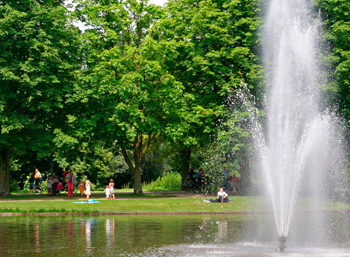
Housed in a fetching nineteenth-century building near the northeastern corner of the Vondelpark, the Nederlands Filmmuseum is really more an arthouse cinema (with two screens) than a museum – a showcase for films of all kinds, most of which are shown in their original language, with subtitles in Dutch or sometimes English. There are several screenings nightly, plus regular matinees, and the programme often follows a prescribed theme or subject. Look out also for news of the free screenings of classic movies in the summer. Behind the museum, just outside the park at Vondelstraat 69, the museum’s film library (Mon, Tues, Thurs & Fri 1–5pm) has a substantial collection of books, magazines and journals, some in English, though they are for reference only.
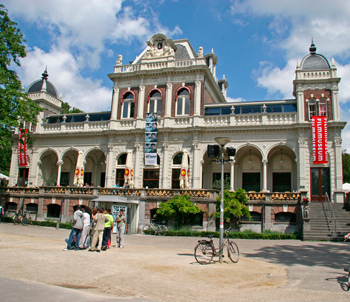
Experts in classical music and opera CDs and sheet music, this shop has perhaps the best selection in the city.
Behind the Concertgebouw, this fashionable and very popular clothes shop features secondhand designer labels, mostly from the 1980s onwards.
The city’s best travel bookshop, with knowledgeable staff and a huge selection of books, maps, inflatable and illuminated globes and more.

Great art and architecture book specialist, with plenty of stuff available in English.
The only thing on offer here is water – over a hundred different types of bottled mineral water from all over the world. If you’re feeling dehydrated –and flush – try a bottle of the deluxe Bling H20 studded in Swarovski crystals; at €49 a pop, it’s the haute couture of spring water.
A café run entirely by children aged 5–12, who cook, waiter and wash dishes. The food is simple – pizzas, sandwiches, cakes – and makes for a very rewarding experience.
The downstairs café at this New Age centre on the edge of the Vondelpark is one of the most peaceful spots in the city, selling a range of drinks and organic snacks and meals. There’s also an upstairs bookshop, and any number of courses in yoga and meditation.
This cosy, very friendly café not far from the Vondelpark makes a nice spot for lunch – excellent sandwiches, toasties, uitsmijters as well as a tapas-type menu, although service can be slow.
Trendy and minimalistic restaurant offering fresh, seasonal products with an international twist. Creative mains will set you back around €25.
Excellent steaks, fries and salads are the order of the day here at this eetcafé. The service can be patchy, but the food is great, and inexpensive. The pleasant outdoor terrace in the summer is a bonus.
Situated just outside the top end of the Vondelpark, across the pedestrian bridge, this is a lovely corner restaurant on a busy canal, serving Belgian and fusion cuisine and a huge range of bottled Belgian beers to enjoy on their summer terrace.
A first-rate range of Italian dishes, both à la carte and in a set menu – three courses for €25. The pizzas are cooked in a wood oven.
This elegant restaurant, with an eclectic French and Italian menu, is popular with a media crowd, since it’s run by a well-known Dutch TV cook. Call to reserve at least a week in advance and dress to impress. Three-course menus are €45.
Excellently prepared Indonesian dishes, with a wide range to choose from; vegetarians are very well taken care of, and the service is generally good. Expect to pay around €20 for a rijsttafel.
Not far from the Concertgebouw, this bar is famous for its Art Deco trimmings, and its large interior and outside seating in summer. The nicest place to drink in the area, and with a decent menu too.
Hobbemastraat 2
![]() 020/616 6664
020/616 6664
Club Fri & Sat 9pm–3am; bar Mon–Thurs 6.30pm–1am, Fri & Sat 6.30pm–3am; restaurant Mon–Thurs 7–11pm, Fri & Sat 7pm–midnight
Brassy and over the top restaurant-cum-club with ostrich leather and gold leaf on the walls. Dress to impress and bring bags of money if you want to be a part of the jet set in-crowd.